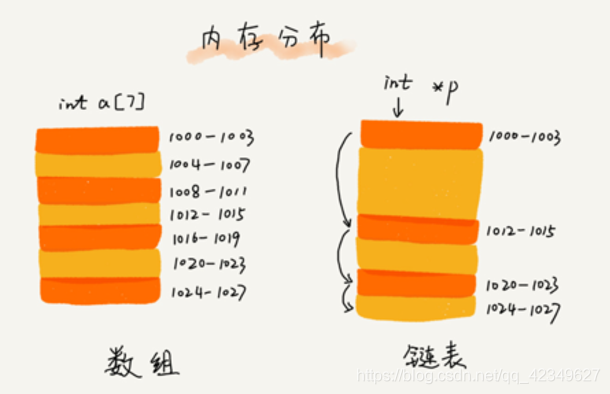1.链表
顺序表的构建需要预先知道数据大小来申请连续的存储空间,而在进行空充时又需要进行数据的搬迁,所以使用起来并不是很灵活。

链表结构可以充分利用计算机内存空间,实现灵活的内存动态管理。

链表(Linked List)是一种常见的基础数据结构,是一只种类线性表,但是不像顺序表一样连续存储数据,而是在每一个节点(数据存储单元)里存放下一个节点的位置信息(即地址)。

2.单链表
单向链表也叫单链表,每个节点包含两个域,一个信息域(元素域)和一个链接域。这个链接指向链表中的下一个节点,而最后一个节点的链接域则指向一个空值。

表元素域elem用来存放具体的数据。
链接域next用来存放下一个节点的位置(python中的标识)
变量p指向链表的头节点(首节点)的位置,从p出发能找到表中的任意节点。
单链表的节点可以单独写个类来存,实例化出结点
class SingleNode(object):
"""单链表的节点"""
def __init__(self,item):
#_item存放数据元素
self.item = item
#_next是下一个节点的标识
self.next = None
然后再写一个类来实例化单链表,这个类封装单链表,里面写了如下函数实现功能

下面就来具体写一下里面的函数:
1.单链表的头部添加元素与尾部添加元素

头部添加元素:把新实例化的结点的next值置为原来链表的头(指向原来链表的头),再把head指向这个新结点;
尾部添加元素:原来链表尾结点的next为None,现在把原来尾部结点的next置为新结点(也就是指向新结点);
def add(self,item):
"""头部添加元素"""
#先创建一个保存item值的节点
node = SingleNode(item)
#将新节点的链接域next指向头节点,即__head指向的位置
node.next = self.__head
#将链表的头__head指向新节点
self.__head = node
def append(self, item):
"""尾部添加元素"""
node = SingleNode(item)
# 先判断链表是否为空,若是空链表,则将__head指向新节点
if self.is_empty():
self.__head = node
# 若不为空,则找到尾部,将尾节点的next指向新节点
else:
cur = self.__head
while cur.next != None:
cur = cur.next
cur.next = node
2.指定位置添加元素

指定位置添加元素:找到指定位置,比如说要插入到第三个结点,则要找第二个结点,把新结点的next置为原来的第三个结点,也就是第二个结点的next值:newnode.next=oldnode.next,然后把第二个结点的next置为要插入的结点。
def insert(self, pos, item):
"""指定位置添加元素"""
# 若指定位置pos为第一个元素之前,则执行头部插入
if pos <= 0:
self.add(item)
# 若指定位置超过链表尾部,则执行尾部插入
elif pos > (self.length()-1):
self.append(item)
# 找到指定位置
else:
node = SingleNode(item)
count = 0
# pre用来指向指定位置pos的前一个位置pos-1,初始从头节点开始移动到指定位置
pre = self.__head
while count < (pos-1):
count += 1
pre = pre.next
# 先将新节点node的next指向插入位置的节点
node.next = pre.next
# 将插入位置的前一个节点的next指向新节点
pre.next = node
3.删除结点

删除头结点:原来的链表头指向要删除的头,现在只要把头(head)指向它的下一个结点就好了。
删除尾结点:只要把尾结点之前的那个结点的next置为None就好了。
删除中间结点:把要删除结点的前一个结点的next置为要删除结点的后一个结点(前一个结点跳过要删除的结点直接指向下下一个结点)。
注意:在c语言中要删除结点,不仅要做以上工作,还要将删除的结点释放(free),但在python中因为他的垃圾回收机制就不需要这样了,它会自动释放。
def remove(self,item):
"""删除节点"""
cur = self.__head
pre = None
while cur != None:
# 找到了指定元素
if cur.item == item:
# 如果第一个就是删除的节点
if not pre:
# 将头指针指向头节点的后一个节点
self.__head = cur.next
else:
# 将删除位置前一个节点的next指向删除位置的后一个节点
pre.next = cur.next
break
else:
# 继续按链表后移节点
pre = cur
cur = cur.next
4.链表长度
求链表长度:依次遍历链表,每循环一次长度加1,直到到达链表尾部;
def __len__(self):
"""
链表长度:
1. 如果当前链表为空, 直接返回0;
1. 如果当前链表不为空, 依次遍历链表的每一个元素,计算长度
"""
if self.is_empty(): #这里调用了判断链表是否为空函数
return 0
else:
cur = self.head
length = 0
while cur != None:
length += 1
cur = cur.next
return length
5.遍历整个链表
遍历整个链表:和求链表长度非常像,求长度是每循环一次长度加1,遍历是每循环一次就打印出结点元素
def trvel(self):
"""遍历链表"""
if not self.is_empty():
cur = self.head
while cur.next != None:
print(cur.element, end=',')
cur = cur.next
print(cur.element)
else:
print("空链表")
6.链表是否为空
判断链表是否为空:直接看链表的头结点是否为空,如果为空,链表就为空,如果不为空,链表就不为空。
def is_empty(self):
"""判断链表是否为空"""
return self.head == None
7.查找结点是否存在
查找结点是否存在:也是一次遍历,如果有结点的item值与传进来的值相等就返回True,如果到最后还没有找到就返回Flase;
整个单链表封装代码:
"""
单链表的封装
"""
class Node(object):
"""
单链表节点的封装
"""
def __init__(self, element):
self.element = element
self.next = None
class SingleLink(object):
"""
单链表的封装
"""
def __init__(self):
# 默认情况下链表为空, 没有任何元素
self.head = None
def is_empty(self):
"""判断链表是否为空"""
return self.head == None
def __len__(self):
"""
链表长度:
1. 如果当前链表为空, 直接返回0;
1. 如果当前链表不为空, 依次遍历链表的每一个元素,计算长度
"""
if self.is_empty():
return 0
else:
cur = self.head
length = 0
while cur != None:
length += 1
cur = cur.next
return length
def trvel(self):
"""遍历链表"""
if not self.is_empty():
cur = self.head
while cur.next != None:
print(cur.element, end=',')
cur = cur.next
print(cur.element)
else:
print("空链表")
def append(self, item):
"""
尾部添加元素
1. 先判断链表是否为空,若是空链表,则将head指向新节点
2. 若不为空,则找到尾部,将尾节点的next指向新节点
"""
node = Node(item)
if self.is_empty():
self.head = node
else:
cur = self.head
while cur.next != None:
cur = cur.next
cur.next = node
def add(self, item):
"""
头部添加元素
1. 先创建一个保存item值的节点
2. 将新节点的链接域next指向头节点,即head指向的位置
3. 将链表的头head指向新节点
"""
node = Node(item)
node.next = self.head
self.head = node
def insert(self, index, item):
"""
指定位置添加元素
1. 若指定位置index为第一个元素之前,则执行头部插入
2. 若指定位置超过链表尾部,则执行尾部插入
3. 否则, 找到指定位置
"""
if index <= 0:
self.add(item)
elif index >= len(self):
self.append(item)
else:
node = Node(item)
count = 0 # 当前位置
cur = self.head
while count < index - 1:
count += 1
cur = cur.next
node.next = cur.next
cur.next = node
def remove(self, item):
"""
删除指定元素的节点:
1 2 3 4 5
1. 如果删除的是头结点, 指针直接指向头结点的下一个节点;
2. 如果删除的不是头结点, 一直循环, 知道找到要删除的节点元素;
"""
pre = None
cur = self.head
if cur.element == item:
self.head = self.head.next
else:
while cur:
if cur.element != item:
pre = cur
cur = cur.next
else:
pre.next = pre.next.next
break
def search(self, item):
"""
判断查找的元素在节点中是否存在, 返回Bool类型
"""
pass
if __name__ == '__main__':
# 实例化单链表对象
link = SingleLink()
# 长度获取
print("链表长度: ", len(link))
# 遍历链表
link.trvel()
print("链表是否为空? ", link.is_empty())
print("添加元素:")
link.append(1)
link.append(2)
link.add(3)
link.insert(1, 'hello')
# 3 'hello' 1 2
# 长度获取
print("链表长度: ", len(link))
# 遍历链表
link.trvel()
print("链表是否为空? ", link.is_empty())
print("删除元素")
link.remove(1)
link.trvel()
3.单向循环链表
只要把单链表尾结点的next指向头就变循环了。

这里写一下查找结点是否存在:
def search(self, item):
"""查找节点是否存在"""
if self.is_empty():
return False
cur = self.__head
if cur.item == item:
return True
while cur.next != self.__head:
cur = cur.next
if cur.item == item:
return True
return False
完整代码在单向循环链表里有写
4.双向链表
每个节点有两个链接:一个指向前一个节点,当此节点为第一个节点时,指向空值;而另一个指向下一个节点,当此节点为最后一个节点时,指向空值。

插入结点
头部插入:

中间插入:

尾部插入:

删除结点:

完整双向链表封装代码:
"""
双向链表的封装
"""
class Node(object):
"""
双向链表节点的封装
"""
def __init__(self, element):
self.element = element # 数据域
# 指针域
self.next = None # 指向后继节点的指针
self.prev = None # 指向前驱节点的指针
def __str__(self):
return self.element
class DuLinkList(object):
"""
双向链表的封装
"""
def __init__(self):
self.head = None
def is_empty(self):
"""判断双向链表是否为空"""
return self.head == None
def __len__(self):
"""获取双向链表的长度"""
if self.is_empty():
return 0
cur = self.head
linkLen = 0
while cur:
cur = cur.next
linkLen += 1
return linkLen
def travel(self):
"""遍历链表元素"""
if not self.is_empty():
cur = self.head
while cur.next != None:
print(cur.element, end=',')
cur = cur.next
print(cur.element)
else:
print("空链表")
def add(self, item):
"""
头部添加元素
1. 先创建一个保存item值的节点
2. 将新节点的链接域next指向头节点,即head指向的位置
3. 将链表的头head指向新节点
"""
node = Node(item)
if self.is_empty():
self.head = node
else:
node.next = self.head
self.head.prev = node
self.head = node
def append(self, item):
"""
尾部添加元素
1. 先判断链表是否为空,若是空链表,则将head指向新节点
2. 若不为空,则找到尾部,将尾节点的next指向新节点
"""
node = Node(item)
if self.is_empty():
self.head = node
else:
cur = self.head
while cur.next != None:
cur = cur.next
cur.next = node
node.prev = cur
def insert(self, index, item):
"""
指定位置添加元素
1. 若指定位置index为第一个元素之前,则执行头部插入
2. 若指定位置超过链表尾部,则执行尾部插入
3. 否则, 找到指定位置
"""
if index <= 0:
self.add(item)
elif index >= len(self):
self.append(item)
else:
node = Node(item)
count = 0 # 当前位置
cur = self.head
while count < index - 1:
count += 1
cur = cur.next
node.next = cur.next
cur.next = node
node.prev = cur
cur.next.prev = node
def remove(self, item):
"""
删除指定元素的节点:
1 2 3 4 5
1. 如果删除的是头结点, 指针直接指向头结点的下一个节点;
2. 如果删除的不是头结点, 一直循环, 知道找到要删除的节点元素;
"""
if self.is_empty():
return
pre = None
cur = self.head
# 如果删除的是头结点, 指针直接指向头结点的下一个节点;
if cur.element == item:
self.head = self.head.next
else:
while cur:
if cur.element != item:
pre = cur
cur = cur.next
else:
# 判断删除的是否为尾部节点, 如果是, 则直接让pre.next指向为None;
if not cur.next:
pre.next = None
break
else:
# pre.next = pre.next.next
pre.next = cur.next
cur.next.prev = pre
break
def search(self, item):
cur = self.head
while cur:
if cur.element == item:
return True
cur = cur.next
else:
return False




















 438
438











 被折叠的 条评论
为什么被折叠?
被折叠的 条评论
为什么被折叠?








